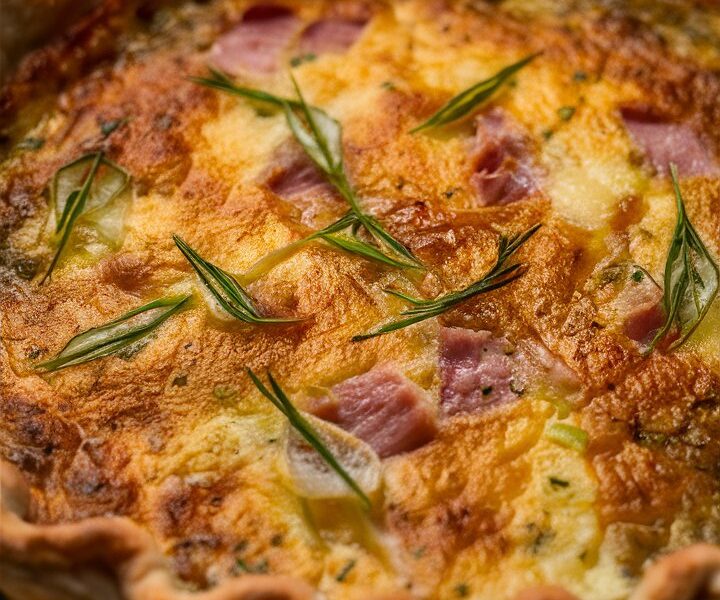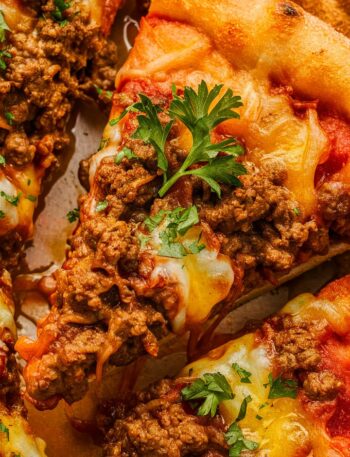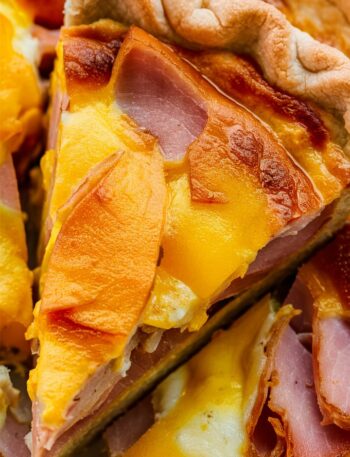Some recipes are more than just food—they are traditions that carry history, memories, and the warmth of family gatherings. Pizza Rustica, also known as Italian Easter Pie or Pizza Gaina, is one such dish.
At first glance, Pizza Rustica looks like a hearty savory pie, golden on the outside and bursting with layers of cured meats, cheeses, and eggs inside. But beyond its appearance, this dish represents centuries of Italian culture. Traditionally made during Easter in southern Italy, it symbolized abundance and joy after the fasting period of Lent. Over time, it traveled to Italian-American homes and became a staple not just at Easter but at Sunday dinners, family reunions, and festive occasions.
This article takes you through everything you need to know about Pizza Rustica—from its origins and cultural significance to detailed instructions, expert tips, creative variations, serving suggestions, storage, and answers to the most common questions. By the end, you’ll not only know how to prepare it but also appreciate the deep heritage baked into every slice.
What is Pizza Rustica?
Pizza Rustica is a savory Italian pie that combines rich ingredients such as ricotta, mozzarella, provolone, parmesan, cured meats, and eggs inside a flaky double crust. It is baked slowly until golden brown and firm enough to slice into wedges.
Unlike the pizza most people think of—flatbread topped with sauce and cheese—Pizza Rustica is closer to a deep-dish pie or quiche. Its filling is dense, flavorful, and satisfying, making it both festive and practical, since one pie can feed a large group.
Regional Names and Variations
- In Naples, it is often called Pizza Chiena or Pizza Gaina.
- In Abruzzo and Molise, it is known as Fiadone.
- Italian-Americans commonly use Pizza Rustica or Easter Pie.
Though names differ, the concept remains the same: a dish of celebration, indulgence, and family togetherness.
Why You’ll Love Pizza Rustica
There are many reasons this dish has endured for generations:
- Layered with Flavor – Each bite brings together salty meats, creamy cheeses, and eggy richness.
- Perfect for Gatherings – Its generous size feeds a crowd, and its appearance is impressive on any table.
- Flexible & Customizable – You can experiment with different meats, cheeses, and even vegetables.
- Make-Ahead Friendly – It actually tastes better after resting overnight, making it ideal for holiday prep.
- Delicious Hot or Cold – Whether fresh from the oven or chilled from the fridge, Pizza Rustica delivers comfort in every bite.
Ingredients You’ll Need
A good Pizza Rustica starts with quality ingredients. Traditionally, Italian families would use whatever they had on hand, which is why no two recipes are exactly the same. Below are the essentials:
🧀 Cheeses
- Ricotta Cheese – The creamy base of the filling. Use whole milk ricotta for richness and drain it for a firmer texture.
- Mozzarella – Adds gooey, mild flavor. Low-moisture mozzarella is preferred.
- Provolone or Fontina – Contributes sharper flavor and depth.
- Parmesan or Pecorino Romano – A salty finishing touch that enhances the overall profile.
🥩 Meats
- Prosciutto – Delicate and slightly sweet.
- Salami – Provides spice and chewiness.
- Soppressata or Capicola – Robust and flavorful regional choices.
- Pancetta – Adds smokiness and richness.
👉 Dice meats into small cubes to distribute evenly throughout the pie.
🥚 Eggs
- Eggs bind the filling and give the pie its signature dense, satisfying texture.
🥧 Crust
- Homemade Pie Crust – Flaky and buttery, strong enough for the heavy filling.
- Store-Bought Crust – A practical shortcut.
- Puff Pastry – For a lighter, crispier take.
🌿 Seasonings
- Black Pepper – A must-have for balancing flavors.
- Fresh Herbs – Optional, but parsley or basil can add brightness.
Step-by-Step Recipe
Making Pizza Rustica requires patience, but the steps are simple.
Step 1: Prepare the Crust
- Preheat oven to 350°F (175°C).
- Roll out your bottom crust and line a 9-inch springform pan or deep pie dish.
- Press the dough firmly into the bottom and sides.
Step 2: Prepare the Filling
- In a large bowl, mix ricotta, mozzarella, provolone, parmesan, and eggs until smooth.
- Season with black pepper.
- Fold in diced meats until evenly combined.
Step 3: Assemble the Pie
- Pour filling into prepared crust.
- Roll out second crust and place on top.
- Seal edges by crimping or pressing with a fork.
- Cut small steam vents.
- Brush with beaten egg for a golden finish.
Step 4: Bake
- Bake for 60–75 minutes, until golden brown and set.
- Tent with foil if browning too quickly.
Step 5: Cool and Serve
- Let rest at least 30–60 minutes before slicing.
- Serve warm, at room temperature, or chilled.
Pro Tips for Perfect Pizza Rustica
- Drain the Ricotta – Removes excess water for a firm, sliceable filling.
- Balance Saltiness – Use a mix of salty and mild meats to prevent overwhelming flavor.
- Choose the Right Pan – A springform pan gives the cleanest slices.
- Cool Before Slicing – Prevents messy cuts and allows flavors to meld.
- Egg Wash the Crust – Creates an appealing golden shine.
Serving Suggestions
Pizza Rustica is hearty, so pair it with lighter sides:
- Fresh Salads – Arugula with lemon vinaigrette or mixed greens.
- Roasted Vegetables – Asparagus, green beans, or peppers.
- Bread and Olives – A rustic Italian touch.
- Drinks – A glass of red wine, sparkling water, or even Prosecco.
Variations and Substitutions
One beauty of Pizza Rustica is its flexibility:
- Vegetarian Version – Replace meats with spinach, mushrooms, or roasted peppers.
- Cheese Lovers’ Pie – Add fontina, asiago, or gorgonzola.
- Spicy Kick – Use hot soppressata or spicy salami.
- Alternative Crusts – Try puff pastry or phyllo dough for lighter versions.
- Mini Pizza Rusticas – Bake in muffin tins for party-sized portions.
Storage and Leftovers
- Refrigerate – Store in an airtight container up to 4 days.
- Freeze – Wrap slices and freeze up to 2 months.
- Reheat – Warm in oven at 325°F or enjoy cold.
Pizza Rustica vs Other Italian Pies
It’s easy to confuse Pizza Rustica with other Italian baked goods, but there are key differences:
- Quiche – French, custard-based, lighter than Pizza Rustica.
- Calzone – Folded pizza dough with filling, handheld, not layered.
- Fiadone – A lighter version made in Abruzzo, often with sweet notes.
Pizza Rustica stands apart for its density, layered filling, and role as a celebratory dish.
Frequently Asked Questions (FAQs)
1. Can I make Pizza Rustica ahead of time?
Yes! It tastes even better after resting overnight.
2. Can I make it vegetarian?
Absolutely—use roasted vegetables, spinach, or mushrooms instead of meats.
3. Do I need to cook the meats first?
No, cured meats like salami and prosciutto are ready to eat.
4. Can I use store-bought crust?
Yes, it works perfectly and saves time.
5. Is Pizza Rustica the same as Pizza Gaina?
Yes, they’re regional names for the same dish.
6. Can I freeze Pizza Rustica?
Yes, wrap slices tightly and freeze for up to two months.
7. What wine pairs best?
Medium-bodied reds like Chianti or Montepulciano complement it beautifully.
8. Can I make mini versions?
Yes, bake in muffin tins for individual servings.
Final Thoughts
Pizza Rustica is more than just an Easter tradition—it’s a dish that brings families together, celebrates abundance, and showcases the rich flavors of Italy. Whether you prepare it the traditional way with layers of meats and cheeses or customize it to suit your own tastes, it is guaranteed to impress.
From its golden crust to its hearty filling, every slice tells a story of tradition, comfort, and celebration. Whether you’re serving it for Easter, Sunday dinner, or simply because you crave something special, Pizza Rustica is sure to become a favorite at your table.
So gather your ingredients, roll out your crust, and bring a piece of Italian heritage into your kitchen. 🍴





